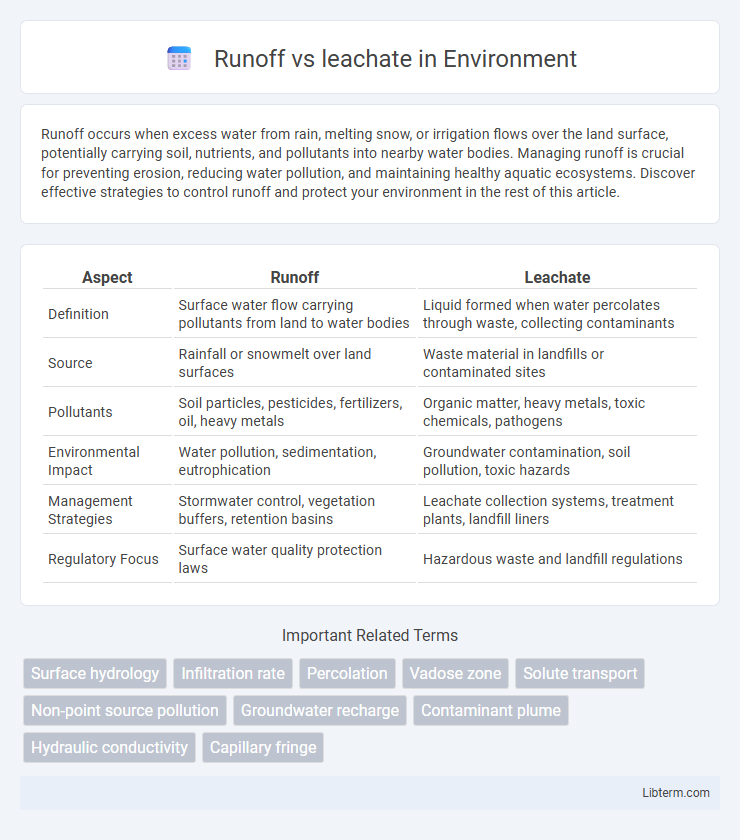Runoff occurs when excess water from rain, melting snow, or irrigation flows over the land surface, potentially carrying soil, nutrients, and pollutants into nearby water bodies. Managing runoff is crucial for preventing erosion, reducing water pollution, and maintaining healthy aquatic ecosystems. Discover effective strategies to control runoff and protect your environment in the rest of this article.
Table of Comparison
| Aspect | Runoff | Leachate |
|---|---|---|
| Definition | Surface water flow carrying pollutants from land to water bodies | Liquid formed when water percolates through waste, collecting contaminants |
| Source | Rainfall or snowmelt over land surfaces | Waste material in landfills or contaminated sites |
| Pollutants | Soil particles, pesticides, fertilizers, oil, heavy metals | Organic matter, heavy metals, toxic chemicals, pathogens |
| Environmental Impact | Water pollution, sedimentation, eutrophication | Groundwater contamination, soil pollution, toxic hazards |
| Management Strategies | Stormwater control, vegetation buffers, retention basins | Leachate collection systems, treatment plants, landfill liners |
| Regulatory Focus | Surface water quality protection laws | Hazardous waste and landfill regulations |
Introduction to Runoff and Leachate
Runoff refers to the water from precipitation that flows over land surfaces without infiltrating into the soil, often carrying pollutants into nearby water bodies. Leachate is the liquid that percolates through waste materials in landfills, collecting soluble and suspended contaminants which pose significant environmental risks if not properly managed. Understanding the differences between runoff and leachate is essential for effective water pollution control and sustainable waste management practices.
Defining Runoff: Meaning and Formation
Runoff refers to the water from precipitation or irrigation that flows over the surface of the land, not absorbed into the soil, eventually draining into rivers, lakes, or oceans. It forms when rainfall intensity exceeds the infiltration capacity of the soil or when the ground is saturated, leading to surface water accumulation and movement. The characteristics of runoff are influenced by factors such as land slope, vegetation cover, soil type, and urban infrastructure.
What Is Leachate? Characteristics and Sources
Leachate is a contaminated liquid generated when water percolates through waste materials in landfills, dissolving organic and inorganic compounds. It typically contains high concentrations of dissolved solids, heavy metals, ammonia, and hazardous chemicals, making it highly toxic and a threat to groundwater quality. Common sources of leachate include municipal solid waste landfills, industrial waste sites, and mining operations, where decomposition and chemical reactions release pollutants into the infiltrating water.
Key Differences Between Runoff and Leachate
Runoff is surface water generated from precipitation that flows over the land, often carrying sediments, nutrients, and contaminants to nearby water bodies, whereas leachate is the liquid that percolates through waste in landfills, containing high concentrations of organic and inorganic pollutants. Key differences include their origin, with runoff arising from rainfall and surface interactions, while leachate originates from the decomposition and moisture of waste material. Runoff typically disperses contaminants over a broader area, while leachate poses a more concentrated pollution risk to soil and groundwater near landfill sites.
Environmental Impact of Runoff
Runoff carries pollutants such as sediments, nutrients, and chemicals from urban and agricultural areas into rivers and lakes, leading to water contamination and ecosystem disruption. It significantly contributes to the eutrophication of aquatic environments, causing algal blooms and oxygen depletion that harm aquatic life. Effective management of runoff is crucial to preventing soil erosion and protecting water quality in surrounding habitats.
Environmental Impact of Leachate
Leachate poses a significant environmental threat due to its potential to contaminate soil and groundwater with hazardous chemicals and heavy metals, resulting from the percolation of water through waste materials. Unlike runoff, which primarily carries surface pollutants, leachate penetrates deeper into ecosystems, causing long-term pollution and ecosystem degradation. Proper management and treatment of leachate are critical to preventing toxic pollution and safeguarding water resources.
Factors Affecting Runoff Generation
Runoff generation is primarily influenced by factors such as soil type, land slope, vegetation cover, and rainfall intensity, which determine the amount and speed of water flow over the surface. Impermeable surfaces increase runoff by preventing water infiltration, while areas with dense vegetation reduce runoff by enhancing water absorption and slowing flow. Soil saturation levels and antecedent moisture conditions also play crucial roles, as saturated soils generate higher runoff due to limited infiltration capacity.
Factors Influencing Leachate Production
Leachate production is primarily influenced by factors such as precipitation intensity, waste composition, moisture content, and landfill design. Higher rainfall increases infiltration, promoting leachate generation, while organic waste decomposition elevates leachate volume and toxicity. Effective landfill liners and drainage systems play a critical role in controlling leachate migration and accumulation.
Methods to Control Runoff and Leachate
Controlling runoff involves methods such as constructing retention basins, implementing permeable pavements, and establishing vegetation buffers to reduce surface water flow and improve infiltration. Leachate management primarily includes collection systems like liners and drainage layers in landfills, along with treatment processes such as biological reactors, reverse osmosis, and chemical precipitation to mitigate contamination. Effective integration of these techniques minimizes environmental impacts from both surface runoff and subsurface leachate leakage.
Conclusion: Managing Water-Related Environmental Risks
Effective management of water-related environmental risks requires distinguishing between runoff and leachate to implement targeted control measures. Runoff, primarily surface water carrying sediments and pollutants from urban or agricultural areas, demands strategies like green infrastructure and stormwater management systems. Leachate, the contaminated liquid from landfills or waste sites, necessitates containment, treatment, and monitoring to prevent groundwater pollution and protect ecosystems.
Runoff Infographic

 libterm.com
libterm.com